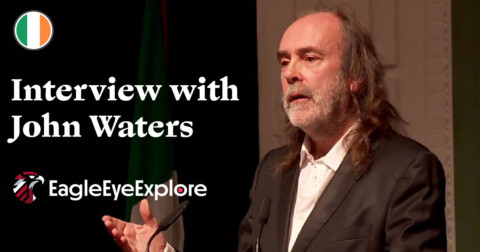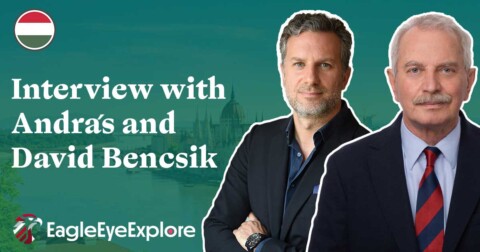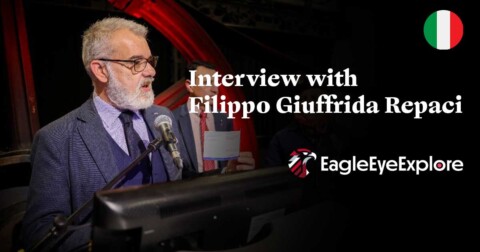Maro Kochinyan is an Armenian human rights activist, co-founder and collaborator of the organizations Armenophobia.org and Hayren: Partners for Humanity. Based in Toronto, Maro advocates against discrimination toward Armenians and promotes a culture of remembrance, youth empowerment, and human rights through creative and strategic initiatives.
Hello, Maro, and thank you for taking the time for this interview with Eagle Eye Explore. First, could you introduce yourself and tell us more about what you and your team do at Armenophobia.org?
I am the co-founder of the NGO Armenophobia.org. Our organization is dedicated to uncovering and combating Armenophobia — systemic hatred, discrimination, and violence against Armenians. Our work includes documenting cases of cultural destruction, state-sponsored propaganda, and historical falsification. We collaborate with international bodies to raise awareness about these injustices and advocate for the protection of Armenian heritage, history, and human rights. Our team consists of researchers, human rights activists, and community leaders. We explore how hatred becomes systemic through state, societal, and educational structures. In addition to documentation, we provide resources to educators and policymakers, aiming to spark dialogue and counter hate-driven ideologies.
Why do some countries — particularly Armenia’s neighbor Azerbaijan — express such strong anti-Armenian sentiment, despite the fact that Armenia has not shown aggression in its recent history?
Today, the pervasive Armenophobia in Azerbaijan, fueled by the authoritarian Aliyev and Pashayev families, is used as a tool of political control. Despite amassing wealth from vast oil and gas reserves, these clans keep the population in poverty, with one of the lowest GDPs per capita in the region. To divert attention from internal issues like economic inequality and corruption, the regime fosters hatred toward Armenians, presenting them as eternal enemies. We are now witnessing the culmination of decades of state-sponsored Armenophobia in Azerbaijan. In September 2023, after months of starvation and blockade, more than 150,000 ethnic Armenians from Artsakh were forcibly displaced within a matter of days. This was not a spontaneous crisis — but the result of a deliberate, well-documented campaign of ethnic cleansing.
In Azerbaijani media and education, Armenians have long been portrayed as “terrorists,” “cancer,” or “vermin.” Children are raised to hate Armenians. Such dehumanization laid the groundwork for the erasure of the entire Armenian presence in the region. Today in Artsakh, the native population and cultural identity are being eradicated: churches are vandalized, monuments looted, the language is vanishing, and cemeteries are destroyed. This is not post-conflict stabilization — this is erasure.
Armenophobia.org’s role is to document and expose these facts, especially when international organizations remain silent or passive. We fight to keep the truth alive, even when people are no longer allowed to stay. These actions are not just morally repugnant — they represent serious violations of international law, including the Geneva Convention, the Genocide Convention, and the Hague Convention for the Protection of Cultural Property. Our mission is to bring these violations to light and demand accountability.
Can we identify some key elements of Azerbaijan’s policies targeting Armenians?
First and foremost, cultural destruction and historical falsification. Azerbaijan is systematically erasing Armenian cultural heritage in Artsakh (Nagorno-Karabakh) and surrounding regions. One of the most infamous examples is the cemetery in Julfa, Nakhchivan, once home to the largest collection of medieval Armenian khachkars, which was destroyed by Azerbaijani forces in 2005–2006.
Videos show soldiers using hammers and machinery to smash over 2,000 intricately carved medieval stone monuments. This act of cultural genocide was followed by claims that Armenians had never lived there. Today, Azerbaijan continues to erase Armenian traces from churches and monasteries: inscriptions in Armenian are removed, and the sites are falsely labeled as “Caucasian Albanian” — a narrative crafted to sever Armenia’s historical connection to the land.
Do these distorted narratives, once introduced into education, become ‘mandatory truths’?
Azerbaijani citizens are indoctrinated from an early age to hate Armenians. In school textbooks, on state TV, and in public speeches, Armenians are depicted as enemies who must be eradicated. Morning school assemblies often begin with slogans like “Death to the enemies,” embedding hatred from a young age. Historical falsifications are widespread — Armenian history and territorial facts are either dismissed or manipulated, while Armenians are portrayed as invaders. Even children’s books and folklore are weaponized to dehumanize Armenians.
And what about moral safeguards?
It’s difficult to speak of them in a climate where acts of violence against Armenians are glorified. One particularly striking case is that of Ramil Safarov, the Azerbaijani soldier who beheaded his Armenian colleague during a NATO training program in Hungary. Upon his extradition to Azerbaijan, Safarov was pardoned, promoted, and celebrated as a national hero. The glorification of violence is deeply embedded in society.
For decades, Azerbaijan has carried out a systematic campaign of ethnic cleansing and violence against Armenians, rooted in profound Armenophobia. This policy reached a new level of brutality in Artsakh but is grounded in a long history of state-sanctioned massacres—from the pogroms in Sumgait (1988) and Baku (1990), where Armenians were hunted, tortured, and killed, to the Maraga massacre in 1992.
Azerbaijan’s intent to erase the Armenian population is unmistakable. Entire communities have been displaced through terror, violence, and impunity.
What exactly do you mean when you say that the events in Artsakh were a manifestation of previously unseen brutality by the Azerbaijani side?
After the 2020 war, the policy escalated: Armenian homes were burned, churches destroyed, and cultural heritage systematically wiped out. In 2023, Azerbaijan imposed an illegal blockade on the Lachin Corridor, starving 150,000 Armenians in a calculated act of collective punishment. This was followed by a final assault and the forced displacement of the entire Armenian population of Artsakh—150,000 people ethnically cleansed in a matter of days. This wasn’t just a humanitarian crisis; it was a textbook case of ethnic cleansing, cultural genocide, and forced population transfer—carried out in full view of the international community.
Under international law, the forced deportation of civilians and the killing of innocents based on ethnicity constitute crimes against humanity. The deliberate destruction of cultural heritage is also explicitly prohibited. These actions match the definition of ethnic cleansing—a systematic removal of an ethnic group from its historical territory. When combined with persistent hatred and mass violence, it fits the legal definition of genocide—the intent to destroy a national group, in whole or in part. Human rights experts warn that the campaign against the Armenian population of Artsakh meets these criteria and poses a serious threat to the survival of that community.

Are there any voices within Azerbaijan that criticize such policies?
The Azerbaijani regime uses every available platform—politics, religion, education, media, even art—to spread Armenophobia. Folklore groups perform dances symbolizing victory over Armenians, dancing on the Armenian flag. Theater performances demonize Armenians, while state-run religious institutions promote anti-Armenian narratives. Children’s books depict how to kill Armenians, and even birthday cards and cake decorations express hatred toward Armenians. This relentless campaign ensures that hatred remains deeply rooted in Azerbaijani society.
In that context, how should we understand the term “Western Azerbaijan”?
The latest propaganda fabrication by the Aliyev regime—so-called “Western Azerbaijan”—is a crude, historically baseless, and legally indefensible attempt to redraw the region’s geography. There is no international recognition, historical legitimacy, or legal foundation to support Azerbaijan’s claim over the sovereign territory of the Republic of Armenia. This narrative was invented by the Azerbaijani dictator as a brainwashing tool for the population, to distract from economic injustice and justify continued hostility toward Armenia. By labeling all of Armenia as “occupied Azerbaijani land,” the regime keeps the nation in a constant state of military alert—all to preserve Aliyev’s authoritarian rule. This revanchist fantasy not only fuels state-driven Armenophobia but also seeks to silence international actors through energy dependence and political blackmail.
You mentioned the lack of international condemnation of the ethnic cleansing in Artsakh. Can you explain why the world remained silent in the face of this tragedy, despite it unfolding in full view of the global community?
The mass expulsion and forced displacement of Armenians from Artsakh following Azerbaijan’s 2023 military offensive is one of the most severe campaigns of ethnic cleansing in the 21st century. Yet this event did not spark significant international attention or action compared to other crises, such as the Russia–Ukraine war or the Israeli–Palestinian conflict. This disproportionate response stems from several factors—first and foremost, geopolitical and economic interests.
Let’s start with energy dependency. Azerbaijan possesses large oil and natural gas reserves, making it a key energy supplier—especially for Europe. The European Union has sought to diversify away from Russian energy sources, increasing its reliance on Azerbaijani energy. Such economic dependency often translates into muted criticism of Azerbaijan’s human rights abuses.
The second factor is strategic geography. Due to its location between Europe and Asia, Azerbaijan plays a critical role in geopolitics, particularly in initiatives like the Southern Gas Corridor. As a result, many states prioritize maintaining good relations with Azerbaijan rather than confronting its actions against Armenians.
Third is the visibility factor. While the ethnic cleansing of Armenians from their ancestral homeland in Artsakh represents a catastrophic human rights violation, it has been overshadowed by larger conflicts involving global powers. Media coverage tends to focus on wars with global economic consequences, leaving smaller nations like Armenia marginalized.
Lastly—and perhaps most insidiously—there is a pervasive perception that hatred against Armenians doesn’t “count” as racism in the global consciousness. There’s a widespread notion that Armenians are “too white” to be victims, “too Christian” to be marginalized, and “too small” to matter geopolitically. This double standard leads to the normalization or outright dismissal of our suffering.
What is the connection between the authoritarian repression you mentioned and the creation of disinformation?
The Aliyev regime invests heavily in international PR campaigns to downplay its actions in Artsakh and spread disinformation. By controlling the narrative and labeling Armenians as aggressors, Azerbaijan reduces international pressure. At the same time, censorship and media suppression are rampant. Under constant threat and repression, independent journalism is virtually impossible in Azerbaijan—meaning that many abuses go unseen by the world.
In your interviews, you often use the term “Caviar Diplomacy.” What exactly do you mean by that?
“Caviar diplomacy” refers to Azerbaijan’s strategy of influencing foreign politicians and institutions through lavish gifts, expensive trips, and financial incentives. Bribery and backdoor deals have helped silence criticism and obscure human rights violations. Investigations revealed that between 2012 and 2014, the Azerbaijani government laundered around $2.9 billion to bribe European officials and suppress reports about political prisoners. This corruption extended even to members of the Parliamentary Assembly of the Council of Europe (PACE), some of whom were expelled or prosecuted. These practices not only undermined the credibility of international institutions, but also enabled Azerbaijan to continue its policy of ethnic cleansing and cultural erasure with impunity.
From Azerbaijan to Armenia’s western neighbor — can you explain Turkey’s denial of the Armenian genocide and the potential consequences of that denial?
This issue is deeply tied to national identity and pride. Acknowledging the Armenian Genocide would undermine the foundation of modern Turkey, since the genocide played a crucial role in creating a homogenous Turkish national identity during the collapse of the Ottoman Empire. Accepting responsibility would challenge deeply rooted nationalist narratives. Legal and financial consequences also play a role. Recognition of the genocide could lead to demands for reparations, return of property, and territorial claims. The Turkish government fears the legal and financial fallout of such recognition. Then there’s domestic politics.
Turkey’s leadership—especially under Recep Tayyip Erdoğan—uses genocide denial to boost nationalist support. Acknowledging past crimes could alienate key voter blocs.
Turkey also promotes Armenophobia as a tool for national unity. From school curricula to political rhetoric, anti-Armenian narratives are institutionalized, maintaining a culture of hatred. Finally, by denying the genocide, Turkey aims to prevent Armenians from achieving justice or territorial rights, which could threaten its influence in the South Caucasus.
You mentioned cultural genocide. Could you explain more specifically what that looks like?
Cultural genocide is the systematic erasure of a people’s history, memory, and presence. In Artsakh, Azerbaijan is destroying Armenian churches, renaming ancient villages, bulldozing cemeteries, and banning the Armenian language. These are not isolated incidents—they are part of a wider, state-organized campaign to eliminate all evidence that Armenians ever lived there. This violates international law and opens the door to historical revisionism. If there are no Armenian monuments, names, or graves, Azerbaijan will be able to claim in 20 years: “Armenians were never here.” This is genocide continued—not by directly killing people, but by erasing their heritage. The Armenian people are very familiar with this tactic. It’s what Turkey did after 1915. Today, Azerbaijan is applying the same strategy—with international support. Moreover, this campaign is not isolated—it’s part of a transnational effort involving both Turkey and Azerbaijan. Turkey’s denial of the genocide and Azerbaijan’s active Armenophobia are two pillars of a broader policy of erasure and regional domination
What message would you send to both your own people and the international community regarding the current challenges facing Armenia and Artsakh, and how can the world help Armenia in present and future struggles?
Armenians around the world must remain united in these difficult times. Internal divisions weaken our ability to face external threats. History has taught us that resilience and unity are our greatest strengths. Now more than ever, national solidarity must be our priority. The challenges facing Armenia and Artsakh are rooted in systemic injustices—from ethnic cleansing and cultural destruction to the global spread of Armenophobia. It is vital for both Armenians and the international community to unite in the fight for justice, accountability, and peace. Also, confront hate speech and discrimination. If you witness hate speech or Armenophobia—do not remain silent. Speak up, assert your rights, and document the incident. Whether it happens online, in education, at work, or in public forums—such behavior must not go unpunished. By standing up to hate, you break down the prejudices that lead to violence and exclusion.
Share stories of discrimination, cultural destruction, or hate via social media, blogs, or activist platforms. Raising awareness is a powerful tool for change. Exposing these cases highlights systemic problems and encourages accountability. Finally, build a strong diaspora network. The Armenian diaspora has always been a force for change. Through global networking, we can create a united front that influences policy, raises awareness, and provides vital support to Armenia and Artsakh.
As for the international community—it must recognize that this is not just a “regional conflict” or an “ethnic dispute.” This is a human rights emergency, rooted in a century of impunity. The forced displacement of 150,000 people in 2023 was not an isolated incident—it was the result of decades of ignored Armenophobia. We want people to understand: silence enables genocide; propaganda can be deadly; and racism against Armenians—if left unchecked—leads to violence, displacement, and genocide. Armenians are not “ancient relics” or “unfortunate victims of war.” We are a living, resilient people who have survived genocide, imperialism, occupation, and discrimination. And we want people to question the narratives they are being fed. If a dictatorship is being applauded for “liberating territory” while simultaneously silencing journalists, imprisoning activists, and destroying churches—that is not peace. That is conquest and occupation.
Can Armenophobia be described as a global phenomenon?
Hate speech and systemic discrimination against Armenians are not limited to Armenia and Azerbaijan. Governments and organizations around the world must recognize the spread of Armenophobia as a global issue. Silence in the face of prejudice enables continued violence and injustice. Countries with Armenian communities should ensure strong legal protections against hate speech and discrimination. Governments must hold individuals and organizations spreading Armenophobia accountable—both nationally and internationally.
Technology companies also need to take responsibility for monitoring and curbing hate speech on their platforms. Armenophobia spreads easily through digital disinformation and propaganda campaigns. Combating this digital violence is a step toward reducing its impact. International institutions, universities, and media outlets should create space for Armenian activists—especially those documenting injustices in Artsakh—to speak out and be heard.





